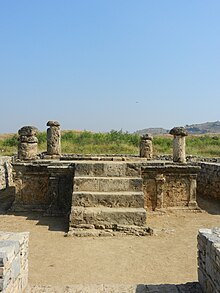|
Jain stupaJain stupa Jain votive plaque with Jain stupa, the "Vasu Śilāpaṭa" ayagapata, 1st century CE, excavated from Kankali Tila, Mathura.[1] The inscription reads: "Adoration to the Arhat Vardhamana. The daughter of the matron (?) courtesan Lonasobhika (Lavanasobhika), the disciple of the ascetics, the junior (?) courtesan Vasu has erected a shrine of the Arhat, a hall of homage (ayagasabha), cistern and a stone slab at the sanctuary of the Nirgrantha Arhats, together with her mother, her daughter, her son and her whole household in honour of the Arhats."[2]  The Jain stupa was a type of stupa erected by the Jains for devotional purposes. A Jain stupa dated to the 1st century BCE-1st century CE was excavated at Mathura in the 19th century, in the Kankali Tila mound.[3] Jain legends state that the earliest Jain stupa was built in the 8th century BCE, before the time of the Jina Parsvanatha.[4] There is a possibly that the Jains adopted stupa worships from the Buddhists, but that is an unsettled point.[5] However the Jain stupa has a peculiar cylindrical three-tier structure, which is quite reminiscent of the Samavasarana, by which it was apparently ultimately replaced as an object of worship.[6] The name for stupa as used in Jain inscriptions is the standard word "thupe".[6] Mathura Jain stupasA Jain stupa dated to the 1st century BCE-1st century CE was excavated at Mathura in the 19th century, in the Kankali Tila mound.[3]
Numerous associated religious works of art were also discovered during the excavations.[3] Many of these are votive tablets, called ayagapatas.[7] They are numerous, and some of the earliest ones have been dated to circa 50-20 BCE.[8] According to Jain legends, five Jain stupas were built in Mathura.[6] AyagapatasThe Jain devotional reliefs called Ayagapatas, particularly that dedicated by Vasu, shows a probable design of the Jain stupa.[6] The stupa drum is set on a high platform, and accessed by a flight of stairs and an ornate torana gate, quite similar in style to the toranas of Sanchi.[6] Niches with images can be seen in front of the platform.[6] The drum of the stupa is elongated and cylindrical, and formed of three superposed tiers separated by railings and decorated bands.[6] The stupa starts to round off only above these three tiers.[6] The platform may have been squared, with Persepolitan-type columns in each corner, similar to those seen in the Vasu Ayagapata.[6] On the Vasu ayagapata, one of the Persepolitan pillars is surmounted by a Dharmachakra wheel, and the other pillar was probably surmounted by an animal, as seen in other similar ayagapatas.[6] The Sivayasa ayagapata shows clearly two triratna symbols on top of the torana, as well as a central flame palmette design.[6] Jain stupas in narrative reliefs  Sculpture from the Mathura archaeological site (Kankali Tila) that depicts the last four Tirthankaras around a stupa, c. 51 CE.  By 100 BCE, a relief from Mathura is known, the Kankali Tila architrave, representing centaurs worshipping a Jain stupa.[14][15] Here again the Jain stupa in the middle of the relief is of cylindrical type with a three-tier design, separated by three horizontal railings.[6] These reliefs are among the first known examples of Jain sculpture.[16] The centaurs appearing in the Mathura reliefs, as in other places such as Bodh Gaya, are generally considered as Western borrowings.[17] Robert Graves (relying on the work of Georges Dumézil,[18] who argued for tracing the centaurs back to the Indian Gandharva), speculated that the centaurs were a dimly remembered, pre-Hellenic fraternal earth cult who had the horse as a totem.[19]  See alsoReferences
|




![Jain torana with triratna symbols and flame palmette designs on top.[6]](http://upload.wikimedia.org/wikipedia/commons/thumb/6/60/Jain_Torana_on_an_Ayagapata_at_Kankali_Tila_75-100_CE.jpg/156px-Jain_Torana_on_an_Ayagapata_at_Kankali_Tila_75-100_CE.jpg)
!["Persian Achaemenian" style capitals appearing in ayagapatas, Mathura, 15-50 CE.[9][10][11]](http://upload.wikimedia.org/wikipedia/commons/thumb/a/ab/Persian_Achaemenian_style_capitals_in_Mathura_15-50_CE.jpg/200px-Persian_Achaemenian_style_capitals_in_Mathura_15-50_CE.jpg)